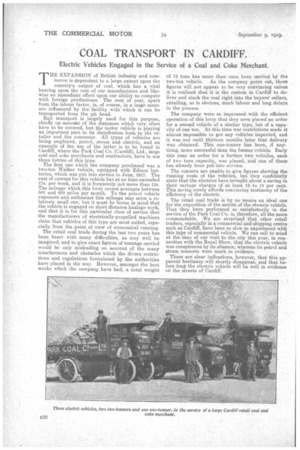COAL TRANSPORT IN CARDIFF.
Page 8

If you've noticed an error in this article please click here to report it so we can fix it.
Electric Vehicles Engaged in the• Service of a Coal and Coke Merchant.
TRE EXPANSION of British industry and cornnrierce is dependent to a large extent upon the countryls output of coal, which has a vital bearing upon the cost of our manufactures and likewise an immediate effect upon our ability to compete with foreign productions. The cost of coal, apart from the labour factor, is, of course, in a large measure. influenced by the facility with which it can be transported from the pit head.
Rail transport is largely used for this purpose, chiefly on account of the distances which very often have to be covered, but the motor vehicle is playing an important part in its distribution both to the retailer and the consumer. All types of vehicles are being employed, petrol, steam and electric' and an example . of the use of the latter is to be found in Cardiff, where the Park Coal Co. (Cardiff), Ltd., large coal and coke merchants and contractors, have in use three lorries of this type. 'The first one which the company purchased was a two-ton Walker vehicle, equipped with Edison batteries, which was put into service in June, 1917; The cost of current for this vehicle has at no time exceeded 17s. per week, and it is frequently not more than 15s. The mileage which this lorry covers averages between 500 and 600 miles per month. To the petrol vehicle exponent and enthusiast this mileage may seem a relatively small one, but it must be borne in mind that the vehicle is engaged on short distance haulage work, and that it is for this particular class of service that the manufacturers of electrically-propelled machines claim that vehicles of this type are most suited, especially from the point of view of economical running. The retail coal trade during the last two years has been beset with many difficulties, as may well be imagined, and to give exact figures of tonnage carried would be only misleading on account of the many interferences and obstacles which the divers restrictions and regulations formulated by the authorities have placed in the way. However' amongst the best weeks which the company have had, a total weight of 75 tons has more than once been carried by the two-ton vehicle. As the company point out, these figures will not appear to be very convincing unless it is realized that it is the custom in Cardiff to deliver and stack the coal right into the buyers' cellars, entailing, as is obvious, much labour and long delays in the process.
The company were so impressed with the efficient operation of this lorry that they soon placed an order for a second vehicle of a similar type, but of a capacity of one ton. At this time war restrictions made it almost impassible to get any vehicles imported, and it was not until thirteen months later that delivery was obtained. This one-tanner has been, if anything, more successful than the former vehicle. Early this year an order for a further two vehicles, each of two tons capacity? was placed, and one of these has already been put into service.
The concern are unable to give figures showing the running costs of the vehicles, but they confidently state that' the electrics have brought about a saving in their cartage charges of at least 12 to 15 per cent. This saving surely affords conOncing testimony of the efficiency of the electric.
The retail coal trade is by no means an ideal one for the exposition of the merits of the electric vehicle. That they have performed so satisfactorily in the service of the Park Coal Co. is, therefore, all the more commendable. We are surprised that other retail traders, especially in a commercial and shipping centre such as Cardiff, have been so slow to experiment with this type of commercial vehicle. We can call to mind at the time of our visit to the city this year, in connection with the Royal Show, that the electric vehicle was conspicuous by its absence, whereas its petrol and steam consorts were m.uch in evidence.
There are clear indications, however, that this apparent hesitancy will shoctly disappear, and that before long the electric vehicle will be well in evidence on the streets of Cardiff.
























